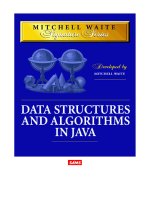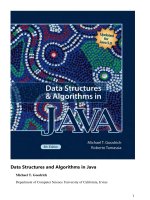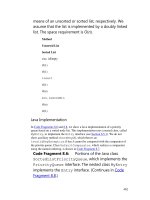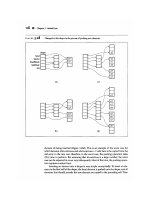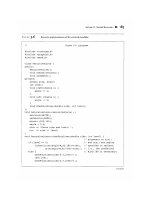Data Structures and Algorithms in Java 4th phần 8 pps
Bạn đang xem bản rút gọn của tài liệu. Xem và tải ngay bản đầy đủ của tài liệu tại đây (1.78 MB, 92 trang )
perform the equivalent of a split operation. Namely, we do a recoloring: we color
v and w black and their parent u red (unless u is the root, in which case, it is
colored black). It is possible that, after such a recoloring, the double red problem
reappears, albeit higher up in the tree T, since u may have a red parent. If the
double red problem reappears at u, then we repeat the consideration of the two
cases at u. Thus, a recoloring either eliminates the double red problem at node z,
or propagates it to the grandparent u of z. We continue going up T performing
recolorings until we finally resolve the double red problem (with either a final
recoloring or a trinode restructuring). Thus, the number of recolorings caused by
an insertion is no more than half the height of tree T, that is, no more than log(n +
1) by Proposition 10.9.
Figure 10.29: Recoloring to remedy the double
red problem: (a) before recoloring and the
corresponding 5-node in the associated (2,4) tree
before the split; (b) after the recoloring (and
corresponding nodes in the associated (2,4) tree after
the split).
646
Figures 10.30 and 10.31 show a sequence of insertion operations in a red-black
tree.
Figure 10.30: A sequence of insertions in a red-
black tree: (a) initial tree; (b) insertion of 7; (c) insertion
of 12, which causes a double red; (d) after
restructuring; (e) insertion of 15, which causes a
double red; (f) after recoloring (the root remains
black); (g) insertion of 3; (h) insertion of 5; (i) insertion
of 14, which causes a double red; (j) after restructuring;
(k) insertion of 18, which causes a double red; (l) after
recoloring. (Continues in Figure 10.31
.)
647
Figure 10.31: A sequence of insertions in a red-
black tree: (m) insertion of 16, which causes a double
red; (n) after restructuring; (o) insertion of 17, which
causes a double red; (p) after recoloring there is again
a double red, to be handled by a restructuring; (q)
after restructuring. (Continued from Figure 10.30
.)
648
The cases for insertion imply an interesting property for red-black trees. Namely,
since the Case 1 action eliminates the double-red problem with a single trinode
restructuring and the Case 2 action performs no restructuring operations, at most
one restructuring is needed in a red-black tree insertion. By the above analysis and
the fact that a restructuring or recoloring takes O(1) time, we have the following:
Proposition 10.10: The insertion of a key-value entry in a red-black tree
storing n entries can be done in O(logn) time and requires O(logn) recolorings and
one trinode restructuring (a restructure operation).
649
Removal
Suppose now that we are asked to remove an entry with key k from a red-black
tree T. Removing such an entry initially proceeds as for a binary search tree
(Section 10.1.2
). First, we search for a node u storing such an entry. If node u
does not have an external child, we find the internal node v following u in the
inorder traversal of T, move the entry at v to u, and perform the removal at v.
Thus, we may consider only the removal of an entry with key k stored at a node v
with an external child w. Also, as we did for insertions, we keep in mind the
correspondence between red-black tree T and its associated (2,4) tree T ′ (and the
removal algorithm for T ′).
To remove the entry with key k from a node v of T with an external child w we
proceed as follows. Let r be the sibling of w and x be the parent of v. We remove
nodes v and w, and make r a child of x. If v was red (hence r is black) or r is red
(hence v was black), we color r black and we are done. If, instead, r is black and v
was black, then, to preserve the depth property, we give r a fictitious double black
color. We now have a color violation, called the double black problem. A double
black in T denotes an underflow in the corresponding (2,4) tree T. Recall that x is
the parent of the double black node r. To remedy the double-black problem at r,
we consider three cases.
Case 1: The Sibling y of r is Black and has a Red Child z. (See Figure 10.32
.)
Resolving this case corresponds to a transfer operation in the (2,4) tree T ′. We
perform a trinode restructuring by means of operation restructure(z). Recall that
the operation restructure(z) takes the node z, its parent y, and grandparent x, labels
them temporarily left to right as a, b, and c, and replaces x with the node labeled
b, making it the parent of the other two. (See also the description of restructure in
Section 10.2.) We color a and c black, give b the former color of x, and color r
black. This trinode restructuring eliminates the double black problem. Hence, at
most one restructuring is performed in a removal operation in this case.
Figure 10.32: Restructuring of a red-black tree to
remedy the double black problem: (a) and (b)
configurations before the restructuring, where r is a
right child and the associated nodes in the
corresponding (2,4) tree before the transfer (two other
symmetric configurations where r is a left child are
possible); (c) configuration after the restructuring and
the associated nodes in the corresponding (2,4) tree
after the transfer. The grey color for node x in parts (a)
650
and (b) and for node b in part (c) denotes the fact that
this node may be colored either red or black.
651
652
Case 2: The Sibling y of r is Black and Both Children of y are Black. (See
Figures 10.33 and 10.34.) Resolving this case corresponds to a fusion operation in
the corresponding (2,4) tree T ′. We do a recoloring; we color r black, we color y
red, and, if x is red, we color it black (Figure 10.33
); otherwise, we color x double
black (Figure 10.34
). Hence, after this recoloring, the double black problem may
reappear at the parent x of r. (See Figure 10.34.) That is, this recoloring either
eliminates the double black problem or propagates it into the parent of the current
node. We then repeat a consideration of these three cases at the parent. Thus,
since Case 1 performs a trinode restructuring operation and stops (and, as we will
soon see, Case 3 is similar), the number of recolorings caused by a removal is no
more than log(n+ 1).
Figure 10.33: Recoloring of a red-black tree that
fixes the double black problem: (a) before the
recoloring and corresponding nodes in the associated
(2,4) tree before the fusion (other similar
configurations are possible); (b) after the recoloring
and corresponding nodes in the associated (2,4) tree
after the fusion.
653
Figure 10.34: Recoloring of a red-black tree that
propagates the double black problem: (a)
configuration before the recoloring and corresponding
nodes in the associated (2,4) tree before the fusion
(other similar configurations are possible); (b)
configuration after the recoloring and corresponding
nodes in the associated (2,4) tree after the fusion.
654
Case 3: The Sibling y of r is Red. (See Figure 10.35
.) In this case, we perform an
adjustment operation, as follows. If y is the right child of x, let z be the right child
of y; otherwise, let z be the left child of y. Execute the trinode restructuring
operation restructure(z), which makes y the parent of x. Color y black and x red.
An adjustment corresponds to choosing a different representation of a 3-node in
the (2,4) tree T ′. After the adjustment operation, the sibling of r is black, and
either Case 1 or Case 2 applies, with a different meaning of x and y. Note that if
Case 2 applies, the double-black problem cannot reappear. Thus, to complete
Case 3 we make one more application of either Case 1 or Case 2 above and we
are done. Therefore, at most one adjustment is performed in a removal operation.
Figure 10.35: Adjustment of a red-black tree in
the presence of a double black problem: (a)
655
configuration before the adjustment and
corresponding nodes in the associated (2,4) tree (a
symmetric configuration is possible); (b) configuration
after the adjustment with the same corresponding
nodes in the associated (2,4) tree.
From the above algorithm description, we see that the tree updating needed after a
removal involves an upward march in the tree T, while performing at most a
656
constant amount of work (in a restructuring, recoloring, or adjustment) per node.
Thus, since any changes we make at a node in T during this upward march takes
O(1) time (because it affects a constant number of nodes), we have the following:
Proposition 10.11: The algorithm for removing an entry from a red-black
tree with n entries takes O(logn) time and performs O(logn) recolorings and at
most one adjustment plus one additional trinode restructuring. Thus, it performs at
most two restructure operations.
In Figures 10.36 and 10.37, we show a sequence of removal operations on a red-
black tree. We illustrate Case 1 restructurings in Figure 10.36c and d. We
illustrate Case 2 recolorings at several places in Figures 10.36 and 10.37. Finally,
in Figure 10.37i
and j, we show an example of a Case 3 adjustment.
Figure 10.36: Sequence of removals from a red-
black tree: (a) initial tree; (b) removal of 3; (c) removal
of 12, causing a double black (handled by
restructuring); (d) after restructuring. (Continues in
Figure 10.37
.)
Figure 10.37: Sequence of removals in a red-
black tree (continued): (e) removal of 17; (f) removal of
657
18, causing a double black (handled by recoloring); (g)
after recoloring; (h) removal of 15; (i) removal of 16,
causing a double black (handled by an adjustment); (j)
after the adjustment the double black needs to be
handled by a recoloring; (k) after the recoloring.
(Continued from Figure 10.36
.)
658
Performance of Red-Black Trees
Table 10.4 summarizes the running times of the main operations of a dictionary
realized by means of a red-black tree. We illustrate the justification for these
bounds in Figure 10.38.
659
Table 10.4: Performance of an n-entry dictionary
realized by a red-black tree, where s denotes the size
of the collection returned by findAll. The space usage
is O(n).
Operation
Time
size, isEmpty
O(1)
find, insert, remove
O(logn)
findAll
O(logn +s)
Figure 10.38: Illustrating the running time of
searches and updates in a red-black tree. The time
performance is O(1) per level, broken into a down
phase, which typically involves searching, and an up
phase, which typically involves recolorings and
performing local trinode restructurings (rotations).
660
Thus, a red-black tree achieves logarithmic worst-case running times for both
searching and updating in a dictionary. The red-black tree data structure is slightly
more complicated than its corresponding (2,4) tree. Even so, a red-black tree has a
conceptual advantage that only a constant number of trinode restructurings are
ever needed to restore the balance in a red-black tree after an update.
10.5.2 Java Implementation
In Code Fragments 10.9 through 10.11, we show the major portions of a Java
implementation of a dictionary realized by means of a red-black tree. The main
class includes a nested class, RBNode, shown in Code Fragment 10.9
, which
extends the BTNode class used to represent a key-value entry of a binary search
tree. It defines an additional instance variable isRed, representing the color of the
node, and methods to set and return it.
Code Fragment 10.9: Instance variables, nested
class, and constructor for RBTree.
661
Class RBTree (Code Fragments 10.9 through 10.11) extends
BinarySearchTree (Code Fragments 10.3 through 10.5). We assume the
parent class supports the method restructure for performing trinode restructurings
(rotations); its implementation is left as an exercise (P-10.3). Class RBTree
inherits methods size, isEmpty, find, and findAll from BinarySearchTree
but overrides methods insert and remove. It implements these two operations by
first calling the corresponding method of the parent class and then remedying any
color violations that this update may have caused. Several auxiliary methods of
class RBTree are not shown, but their names suggest their meanings and their
implementations are straightforward.
Code Fragment 10.10: The dictionary ADT method
insert and auxiliary methods createNode and
remedyDoubleRed of class RBTree.
662
Methods insert (Code Fragment 10.10
) and remove (Code Fragment 10.11) call the
corresponding methods of the superclass first and then rebalance the tree by calling
663
auxiliary methods to perform rotations along the path from the update position
(given by the actionPos variable inherited from the superclass) to the root.
Code Fragment 10.11: Method remove and auxiliary
method remedyDoubleBlack of class RBTree.
664
665
10.6 Exercises
For source code and help with exercises, please visit
java.datastructures.net
.
Reinforcement
R-10.1
We defined a binary search tree so that keys equal to a node's key can be in
either the left or right subtree of that node. Suppose we change the definition so
that we restrict equal keys to the right subtree. What must a subtree of a binary
search tree containing only equal keys look like in this case?
R-10.2
How many different binary search trees can store the keys {1,2,3}?
R-10.3
How many different binary search trees can store the keys {1,2,3,4}?
R-10.4
Insert, into an empty binary search tree, entries with keys 30, 40, 24, 58, 48, 26,
11, 13 (in this order). Draw the tree after each insertion.
R-10.5
Suppose that the methods of BinarySearchTree (Code Fragments 10.3–
10.5
) are used to perform the updates shown in Figures 10.3, 10.4, and 10.5.
What is the node referenced by action Pos after each update?
R-10.6
Dr. Amongus claims that the order in which a fixed set of entries is inserted into
a binary search tree does not matter—the same tree results every time. Give a
small example that proves he is wrong.
R-10.7
Dr. Amongus claims that the order in which a fixed set of entries is inserted into
an AVL tree does not matter—the same AVL tree results every time. Give a
small example that proves he is wrong.
R-10.8
666
Are the rotations in Figures 10.8 and 10.10 single or double rotations?
R-10.9
Draw the AVL tree resulting from the insertion of an entry with key 52 into the
AVL tree of Figure 10.10b
.
R-10.10
Draw the AVL tree resulting from the removal of the entry with key 62 from the
AVL tree of Figure 10.10b
.
R-10.11
Explain why performing a rotation in an n-node binary tree represented using an
array list takes Ω(n) time.
R-10.12
Is the search tree of Figure 10.19a a (2,4) tree? Why or why not?
R-10.13
An alternative way of performing a split at a node v in a (2,4) tree is to partition
v into v ′ and v ′′, with v ′ being a 2-node and v ′′ a 3-node. Which of the keys k
1
,
k
2
, k
3
, or k
4
do we store at v's parent in this case? Why?
R-10.14
Dr. Amongus claims that a (2,4) tree storing a set of entries will always have the
same structure, regardless of the order in which the entries are inserted. Show
that he is wrong.
R-10.15
Draw four different red-black trees that correspond to the same (2,4) tree.
R-10.16
Consider the set of keys K = {1,2,3,4,5,6,7,8,9,10,11,12,13,14,15}.
a.
Draw a (2,4) tree storing K as its keys using the fewest number of nodes.
b.
Draw a (2,4) tree storing K as its keys using the maximum number of nodes.
667
R-10.17
Consider the sequence of keys (5,16,22,45,2,10,18,30,50,12,1). Draw the result
of inserting entries with these keys (in the given order) into
a.
An initially empty (2,4) tree.
b.
An initially empty red-black tree.
R-10.18
For the following statements about red-black trees, provide a justification for
each true statement and a counterexample for each false one.
a.
A subtree of a red-black tree is itself a red-black tree.
b.
The sibling of an external node is either external or it is red.
c.
There is a unique (2,4) tree associated with a given red-black tree.
d.
There is a unique red-black tree associated with a given (2,4) tree.
R-10.19
Draw an example red-black tree that is not an AVL tree.
R-10.20
Consider a tree T storing 100,000 entries. What is the worst-case height of T in
the following cases?
a.
T is an AVL tree.
b.
668
T is a (2,4) tree.
c.
T is a red-black tree.
d.
T is a splay tree.
e.
T is a binary search tree.
R-10.21
Perform the following sequence of operations in an initially empty splay tree
and draw the tree after each set of operations.
a.
Insert keys 0, 2, 4, 6, 8, 10, 12, 14, 16, 18, in this order.
b.
Search for keys 1, 3, 5, 7, 9, 11, 13, 15, 17, 19, in this order.
c.
Delete keys 0, 2, 4, 6, 8, 10, 12, 14, 16, 18, in this order.
R-10.22
What does a splay tree look like if its entries are accessed in increasing order by
their keys?
R-10.23
Explain how to use an AVL tree or a red-black tree to sort n comparable
elements in O(nlogn) time in the worst case.
R-10.24
Can we use a splay tree to sort n comparable elements in O(nlogn) time in the
worst case? Why or why not?
Creativity
669
C-10.1
Design a variation of algorithm TreeSearch for performing the operation
findAl(k) in an ordered dictionary implemented with a binary search tree T,
and show that it runs in time O(h + s), where h is the height of T and s is the size
of the collection returned.
C-10.2
Describe how to perform an operation removeAll(k), which removes all the
entries whose keys equal k in an ordered dictionary implemented with a binary
search tree T, and show that this method runs in time O(h + s), where h is the
height of T and s is the size of the iterator returned.
C-10.3
Draw a schematic of an AVL tree such that a single remove operation could
require Ω(logn) trinode restructurings (or rotations) from a leaf to the root in
order to restore the height-balance property.
C-10.4
Show how to perform an operation, removeAll(k), which removes all entries
with keys equal to K, in a dictionary implemented with an AVL tree in time
O(slogn), where n is the number of entries in the dictionary and s is the size of
the iterator returned.
C-10.5
If we maintain a reference to the position of the left-most internal node of an
AVL tree, then operation first (Section 9.5.2) can be performed in O(1) time.
Describe how the implementation of the other dictionary methods needs to be
modified to maintain a reference to the left-most position.
C-10.6
Show that any n-node binary tree can be converted to any other n-node binary
tree using O(n) rotations.
C-10.7
Let D be an ordered dictionary with n entries implemented by means of an AVL
tree. Show how to implement the following operation on D in time O(logn + s),
where s is the size of the iterator returned:
findAllInRange(k
1
,k
2
): Return an iterator of all the entries in D with key k
such that k
1
≤ k ≤ k
2
.
670

